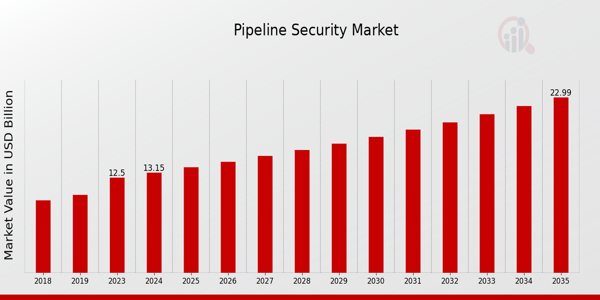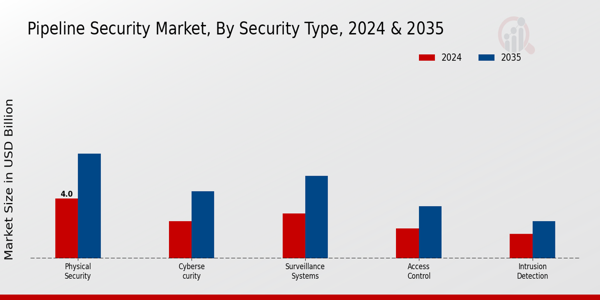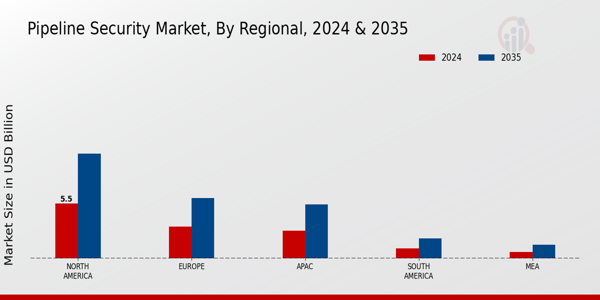Pipeline Security Market Overview
The Pipeline Security Market Size was estimated at 12.5 (USD Billion) in 2023. The Pipeline Security Market Industry is expected to grow from 13.15(USD Billion) in 2024 to 23.0 (USD Billion) by 2035. The Pipeline Security Market CAGR (growth rate) is expected to be around 5.21% during the forecast period (2025 - 2035).
Key Pipeline Security Market Trends Highlighted
The Global Pipeline Security Market is experiencing significant growth driven by increasing concerns over infrastructure safety and the rising number of pipeline-related incidents. As security threats evolve, the need for advanced monitoring and protective technologies has become more pronounced. Government regulations aimed at ensuring the safety and integrity of pipeline systems are also propelling demand for reliable security solutions. Additionally, a growing focus on environmental protection raises the importance of preventing leaks and spills, further fueling advancements in pipeline security technologies.
Amid these developments, various opportunities exist for market players to explore further.The integration of cutting-edge technologies such as artificial intelligence, machine learning, and smart sensors presents avenues for creating more efficient and effective security systems. Furthermore, expanding into emerging markets where pipeline infrastructure is being developed can open new growth channels. Collaborations with technology providers and government agencies can enhance innovation and foster solutions tailored to specific regional needs. In recent times, there has been a noticeable trend toward adopting a holistic approach to pipeline security.
Companies are moving beyond reactive measures to embrace proactive strategies that emphasize risk assessment and management.Additionally, the increasing importance of cybersecurity in the physical security of pipelines has become apparent, as digital threats pose similar risks to physical infrastructure. The development of integrated security solutions, which encompass both physical and cyber domains, is becoming more common. This trend signifies a shift toward comprehensive security measures that address the complexities of modern pipeline operations while ensuring safety and resilience in the face of evolving threats.

Source: Primary Research, Secondary Research, MRFR Database and Analyst Review
Pipeline Security Market Drivers
Increasing Incidents of Pipeline Security Breaches
The Global Pipeline Security Market has been propelled due to increasing data breaches and cyber security threats to critical pipeline systems. Pipelines as resources aid in catering to the rising demand for petroleum and natural gas, but at the same time need to be secured from threats such as vandalism, terrorism, or cyber incidents. Security breaches such as explosions, leaks, and vandalism lead to damage to the environment whilst adding up to restrict financial resources in the system.
In order to lessen these security risks, pipeline operators are extensively investing in advanced protection measures. Research indicates there is a rise in investment in modern surveillance systems, cyber security systems, and threat detection to boost the resilience of pipeline systems. There is an increase in compliance regulations enforced by regulatory bodies that encourage companies to adopt stricter measures to ensure operational and public safety.Global Pipeline Security Market’s growth is aligned with the enhanced perception of security risks that users intend to solve with innovative mechanisms that lessen threats.
Regulatory Compliance and Industry Standards
As the Global Pipeline Security Market Industry evolves, the drive toward regulatory compliance has emerged as a key market driver. Governments and industry organizations across countries are implementing stricter regulations and standards to ensure the security of pipelines against potential threats, including sabotage and cybersecurity vulnerabilities. Compliance with these regulations not only protects infrastructure but also assures stakeholders of the safety and reliability of energy supply chains.As a result, pipeline operators are compelled to invest in advanced security technologies and methodologies to meet these compliance requirements, which in turn propels the growth of the pipeline security market.
Technological Advancements in Security Solutions
Technological advancements play a crucial role in shaping the Global Pipeline Security Market Industry. The emergence of advanced surveillance systems, drones, sensors, and data analytics tools enhances the ability to monitor and secure pipeline networks effectively. These technologies facilitate real-time threat detection, incident response, and ongoing risk assessments, thereby improving overall pipeline security. The continuous innovation in security solutions not only enhances operational efficiencies but also reduces the likelihood of costly security incidents, driving further investment and growth in the pipeline security market.
Pipeline Security Market Segment Insights
Pipeline Security Market Security Type Insights
The Global Pipeline Security Market has been increasingly prioritizing Security Type as a vital aspect of its growth and development. In 2024, the market is valued at approximately 13.15 USD Billion, with notable contributions from various security mechanisms. A prominent component is Physical Security, which accounts for 4.0 USD Billion in 2024 and is expected to rise significantly to 7.0 USD Billion by 2035, highlighting its critical role in safeguarding physical assets against potential threats. Cybersecurity is also crucial in this domain, valued at 2.5 USD Billion in 2024 and projected to increase to 4.5 USD Billion by 2035, emphasizing the growing need for protective measures against cyber threats that are evolving with technology.
Surveillance Systems, another essential element, is valued at 3.0 USD Billion in 2024 and is expected to reach 5.5 USD Billion by 2035, indicating its importance in real-time monitoring to prevent incidents before they escalate. Access Control stands at 2.0 USD Billion in 2024 and aims for 3.5 USD Billion by 2035, reflecting its pivotal role in restricting unauthorized access to sensitive areas, thereby securing the pipeline infrastructure. Lastly, Intrusion Detection is valued at 1.65 USD Billion in 2024 and is anticipated to grow to 2.5 USD Billion by 2035, a segment that provides an essential layer of security by promptly alerting stakeholders to breaches or unauthorized entries.
Each of these elements plays a significant role in the overall security landscape, with Physical Security and Surveillance Systems majorly holding the market share due to their direct impact on the physical integrity and safety of pipelines. Additionally, growing threats to both physical and virtual environments propel a rise in investments in these security types, creating a dynamic environment for the Global Pipeline Security Market.
The segmentation showcases a blend of physical protection and technological advancements, ensuring comprehensive coverage against diverse threats.Overall, the Global Pipeline Security Market industry continues to evolve by integrating advanced technology and methodologies to enhance pipeline safety and security while addressing real-world challenges. The market growth is driven by a combination of increased demand for safeguards against risks and proposes a framework for collaborative efforts to mitigate potential threats industry-wide.

Source: Primary Research, Secondary Research, MRFR Database and Analyst Review
Pipeline Security Market Deployment Type Insights
The Global Pipeline Security Market is showcasing a diverse Deployment Type landscape, which includes On-Premises, Cloud-Based, and Hybrid solutions. In 2024, the market is expected to attain a valuation of 13.15 billion USD, reflecting a strong demand for robust security measures against threats to pipeline infrastructures. The On-Premises deployment approach is gaining traction due to its control and customization potential; organizations favor this model when regulatory compliance and data privacy are significant concerns. Meanwhile, the Cloud-Based segment is witnessing notable growth, driven by its flexibility and cost-effectiveness, enabling organizations to scale their security measures without substantial upfront investments.
The Hybrid model, combining both On-Premises and Cloud solutions, is also becoming increasingly relevant as businesses seek to leverage the advantages of both environments. This balanced approach facilitates enhanced security while optimizing resources, catering to varying operational needs. The Global Pipeline Security Market segmentation highlights these deployment types' adaptability and importance in addressing emerging security challenges. As businesses continue to recognize the threats posed to critical pipeline infrastructures, the demand for tailored deployment solutions is expected to grow, reflecting broader trends in the cybersecurity landscape.
Pipeline Security Market End User Insights
The End User segment of the Global Pipeline Security Market plays a crucial role in ensuring the safety and reliability of essential infrastructures. In 2024, the market is valued at approximately 13.15 USD billion and is projected to grow significantly in the coming years. The Oil Gas sector is a major player within this segment, driven by the necessity to protect pipelines from theft, sabotage, and environmental hazards. The Water Wastewater sector also demonstrates significant demand due to the need for constant surveillance and protection of critical supplies, thereby ensuring public health.
Chemical Industries utilize pipeline security measures to mitigate risks associated with hazardous materials, while the Mining sector relies heavily on pipeline infrastructure for transportation, creating an opportunity for growth in security investments. Utilities, being pivotal for energy distribution, also contribute significantly to the market as they implement advanced security solutions to safeguard their pipeline networks. Overall, these sectors exhibit vital importance for the Global Pipeline Security Market, showcasing various growth drivers such as technological advancements and increasing regulatory mandates.
Pipeline Security Market Component Insights
The Global Pipeline Security Market, valued at 13.15 USD Billion in 2024, encompasses critical components that play a vital role in ensuring the safety and integrity of pipeline infrastructure. This market comprises various segments, including Hardware, Software, and Services, each contributing uniquely to the overall ecosystem. Hardware solutions typically dominate this landscape due to their fundamental role in physical security measures such as surveillance systems and intrusion detection. Meanwhile, Software solutions are increasingly pivotal in facilitating real-time monitoring, analytics, and risk management.
The Services segment, which includes consultancy and maintenance support, has seen significant growth as organizations seek to enhance compliance and operational efficiency. The evolving nature of threats faced by pipeline operators has led to increased investments in sophisticated technologies across these components, ultimately driving market growth. Furthermore, the demand for integrated solutions that combine hardware and software capabilities is reshaping the Global Pipeline Security Market landscape, presenting numerous opportunities for stakeholders to innovate and improve system resilience while addressing emerging security challenges.Key trends indicate a rising focus on automation and digitalization, underscoring the importance of each component in maintaining pipeline security effectively.
Pipeline Security Market Regional Insights
The Regional segment of the Global Pipeline Security Market shows significant growth and variation across different regions. North America holds a dominant position, with a market valuation of 5.5 USD Billion in 2024, projected to reach 10.52 USD Billion by 2035, representing the majority holding in market growth due to increased investment in infrastructure and technology. Europe follows with a valuation of 3.2 USD Billion in 2024, expected to rise to 6.06 USD Billion by 2035, driven by stringent regulations and a focus on enhancing security measures for energy pipelines.
The APAC region, valued at 2.8 USD Billion in 2024, is anticipated to grow to 5.44 USD Billion, showcasing significant opportunities, particularly in emerging economies prioritizing energy security. South America and the MEA regions are comparatively smaller but are important, with valuations of 1.0 USD Billion and 0.65 USD Billion in 2024, respectively, expected to grow to 2.0 USD Billion and 1.38 USD Billion by 2035. These regions present unique challenges and opportunities, indicating a growing awareness and need for pipeline security solutions, contributing to the overall Global Pipeline Security Market revenue and industry dynamics.

Source: Primary Research, Secondary Research, MRFR Database and Analyst Review
Pipeline Security Market Key Players and Competitive Insights
The Global Pipeline Security Market is characterized by a dynamic competitive landscape driven by the increasing demand for the protection of critical infrastructure. With the exponential growth of pipeline networks across various regions, ensuring their security has become paramount, leading to the emergence of numerous players offering innovative solutions. The market has seen significant investments in advanced technologies, including surveillance systems, leak detection sensors, and cybersecurity frameworks, to mitigate threats from natural disasters, vandalism, and cyber-attacks. The competitive insights reveal a trend where companies leverage partnerships and collaborations to enhance their service portfolios and extend their geographical reach.
This evolving market environment requires players to adopt robust strategies that focus on technological advancements, regulatory compliance, and customer-centric offerings to remain competitive.Worley has established itself as a formidable player in the Global Pipeline Security Market through its comprehensive suite of security solutions tailored to meet the specific needs of pipeline operators. The company's expertise in engineering and project delivery, combined with a strong emphasis on safety and environmental stewardship, allows it to deliver end-to-end support for pipeline security initiatives. Worley's strengths lie in its ability to provide customized security assessments that identify vulnerabilities, along with its proficiency in deploying cutting-edge technology for monitoring and threat detection.
Furthermore, the company's extensive global footprint provides it with a significant competitive advantage, enabling it to serve clients across diverse regions and regulatory landscapes effectively. The integration of digital solutions into its service offerings ensures that Worley remains at the forefront of innovation in the pipeline security domain.Baker Hughes is another significant contributor to the Global Pipeline Security Market, recognized for its innovative technologies and solutions addressing the complexities of pipeline protection.
The company's commitment to enhancing operational integrity and reducing risks positions it as a trusted partner for organizations looking to secure their pipeline infrastructure. Baker Hughes leverages its robust technical expertise and broad portfolio of security solutions to offer comprehensive risk management services, focusing on threat assessment and incident response strategies. The integration of advanced analytical tools and predictive modeling techniques enables the company to enhance the reliability and efficiency of pipeline operations. With a strong emphasis on collaboration with industry stakeholders and a proactive approach to adopting emerging technologies, Baker Hughes is well-positioned to meet the evolving security demands in the pipeline sector, driving sustainable growth in the market.
Key Companies in the Pipeline Security Market Include
- Worley
- Baker Hughes
- Siemens Energy
- National Oilwell Varco
- General Electric
- ABB
- Siemens
- Kongsberg Gruppen
- Schneider Electric
- TechnipFMC
- Babcock International
- Honeywell
- Emerson
- SNCLavalin
- Flir Systems
Pipeline Security Market Industry Developments
The Global Pipeline Security Market has seen significant recent developments, particularly regarding investments and advancements in technology aimed at enhancing security measures. Companies such as Baker Hughes and Siemens Energy are actively engaging in innovative solutions to counter pipeline threats, focusing on integrating AI and IoT technologies for better monitoring and response times. Additionally, Worley has been focusing on strategic collaborations that aim to bolster pipeline integrity management through advanced analytics.
Recent mergers and acquisitions in the sector include Schneider Electric's acquisition of a leading cybersecurity firm aimed at strengthening their position in the pipeline sector, while Honeywell and Emerson are exploring partnerships to expand their digital solutions for pipeline security. National Oilwell Varco continues to expand its portfolio with acquisitions targeted at enhancing cybersecurity measures linked to pipeline operations. Reports indicate that companies like Kongsberg Gruppen and General Electric are witnessing growth in their market valuation due to the rising global emphasis on improving pipeline safety and security, driven by increased regulatory scrutiny and the need for more resilient infrastructure. These movements signify robust changes that are shaping the future landscape of the Global Pipeline Security Market.
Pipeline Security Market Segmentation Insights
Pipeline Security Market Security Type Outlook
- Physical Security
- Cybersecurity
- Surveillance Systems
- Access Control
- Intrusion Detection
Pipeline Security Market Deployment Type Outlook
- On-Premises
- Cloud-Based
- Hybrid
Pipeline Security Market End User Outlook
- Oil Gas
- Water Wastewater
- Chemical Industries
- Mining
- Utilities
Pipeline Security Market Component Outlook
- Hardware
- Software
- Services
Pipeline Security Market Regional Outlook
- North America
- Europe
- South America
- Asia Pacific
- Middle East and Africa
Pipeline Security Market Report Scope
|
Report Attribute/Metric
|
Details
|
|
Market Size 2023
|
12.5(USD Billion)
|
|
Market Size 2024
|
13.15(USD Billion)
|
|
Market Size 2035
|
23.0(USD Billion)
|
|
Compound Annual Growth Rate (CAGR)
|
5.21% (2025 - 2035)
|
|
Report Coverage
|
Revenue Forecast, Competitive Landscape, Growth Factors, and Trends
|
|
Base Year
|
2024
|
|
Market Forecast Period
|
2025 - 2035
|
|
Historical Data
|
2019 - 2024
|
|
Market Forecast Units
|
USD Billion
|
|
Key Companies Profiled
|
Worley, Baker Hughes, Siemens Energy, National Oilwell Varco, General Electric, ABB, Siemens, Kongsberg Gruppen, Schneider Electric, TechnipFMC, Babcock International, Honeywell, Emerson, SNCLavalin, Flir Systems
|
|
Segments Covered
|
Security Type, Deployment Type, End User, Component, Regional
|
|
Key Market Opportunities
|
Increased investment in infrastructure protection, Growing adoption of IoT-based security solutions, Rising demand for cybersecurity integration, Enhanced regulatory compliance requirements, and Expansion in emerging markets.
|
|
Key Market Dynamics
|
increased cyber threats, aging infrastructure concerns, regulatory compliance requirements, rising investment in security technologies, growing awareness of pipeline vulnerabilities
|
|
Countries Covered
|
North America, Europe, APAC, South America, MEA
|
Frequently Asked Questions (FAQ) :
The Global Pipeline Security Market is expected to be valued at 13.15 USD Billion in 2024.
By 2035, the Global Pipeline Security Market is projected to reach a value of 23.0 USD Billion.
The expected CAGR for the Global Pipeline Security Market from 2025 to 2035 is 5.21%.
North America will have the largest market share in the Global Pipeline Security Market, valued at 5.5 USD Billion in 2024.
The Physical Security segment of the Global Pipeline Security Market is valued at 4.0 USD Billion in 2024.
Major players in the Global Pipeline Security Market include Worley, Baker Hughes, Siemens Energy, and General Electric.
By 2035, the market value of Cybersecurity in the Global Pipeline Security Market is expected to reach 4.5 USD Billion.
The anticipated market value for the Surveillance Systems segment in 2024 is 3.0 USD Billion.
The Europe region is projected to grow to 6.06 USD Billion by 2035.
The market size for Access Control in the Global Pipeline Security Market is expected to be 3.5 USD Billion by 2035.
















